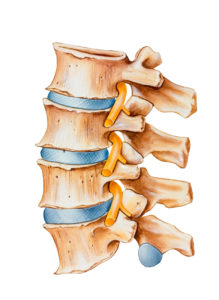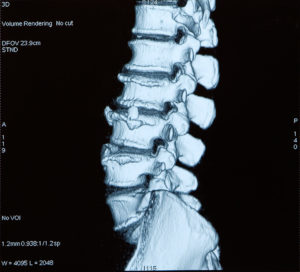Degenerative disc disease (DDD) of the lumbar spine is a relatively common condition in aging adults. Our intervertebral discs serve as shock absorbers for the spine, and as we age they gradually dry out, losing strength and resiliency. These changes are gradual in most people. In fact, many of our patients don’t know they have degenerative disc disease. They only become aware of the condition when being examined for another health problem.
Symptoms of Lumbar DDD
Disc degeneration in itself is not usually a problem; it is a normal aging process. However, DDD can cause the discs to lose height, resulting in nerve pathways narrowing and causing nerve impingement, inflammation, and pain. In severe cases, this neurogenic pain may be constant. DDD may also cause mechanical pain, which results from the degeneration of the disc (the “shock absorber”) leading to bones in the spine pressing against each other.
Diagnosing Lumbar DDD
The physicians here at our practice care about your health. To make an accurate diagnosis, we will use a combination of tools and sophisticated technology:
- Medical history. We will talk to you about your symptoms, their severity, and the treatments you have already tried.
- Physical examination. You will be carefully examined by one of our spine specialists for limitation of movement, problems with balance, pain, loss of reflexes in the extremities, muscle weakness, loss of sensation or other signs of neurological damage.
- Diagnostic tests. Generally, we start with x-rays, which allow us to rule out other problems such as tumors and infections. An MRI will be taken to enable the physicians to assess the degree of disc degeneration, especially any loss of disc height. In some cases we also use a test called a discography to confirm the diagnosis. This test involves injecting contrast dye into the affected disc (or discs) to create a clearer image.
Non-Operative Treatment of Lumbar DDD
For acute or sudden low back pain, we can prescribe pain relief medications such as acetaminophen, anti-inflammatory agents, and muscle relaxants. Temporary bed rest may also be suggested. But patients are encouraged to get up and gradually resume their activities.
We strongly believe in continuing your treatment even after you leave our facility. That is why we prescribe physical therapy for patients who can benefit from it. For lumbar DDD, prescribed stretching exercises can improve flexibility, and extension exercises help maintain the spine’s natural curve. Hot/cold therapy and gentle massage can also be beneficial for low back pain.
After acute symptoms subside (usually within two to three weeks), patients are encouraged to begin a daily exercise regimen. This may include low impact aerobics three times per week as well as daily back exercises.
Surgical Treatments
If symptoms of lumbar DDD persist despite these non-operative treatments, further diagnostic tests may be necessary. These tests may include an MRI, CT Scan, Myelogram, and possibly Discography. If the surgeon discovers that one or more of the vertebral discs are damaged and are causing pain or other symptoms (e.g. weakness in muscles), surgery may be necessary. The surgical procedure is likely to include a discectomy (removal of the degenerated disc) and interbody fusion (fusing together of the vertebrae above and below the removed disc).
For these type of surgeries, surgeons often use the latest minimally invasive surgical techniques, which result in rapid patient recovery. Of course, if surgery is necessary, your surgeon will clearly explain the procedure to you prior to your surgery.
Recovery
While lumber DDD is a natural part of aging, it does not mean you have to live with low back pain. We can help you return to a healthy, pain-free and active life. For most patients this can be accomplished with non-surgical treatments. But even if surgery is needed, be assured that we will discuss with you all risks and benefits of the procedure and provide you with the best care possible.
In addition to these treatments, the medical professionals at our practice have a deep commitment to patient education. By helping patients understand the causes of their conditions we can also help them to eliminate risk factors and to build “spine healthy habits” into their lives. While you are under our care, our medical staff will provide you with excellent information to help you recover, minimize risk factors and to stay healthy.



